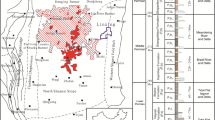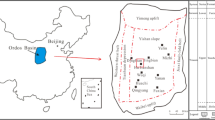Diagenesis is a series of physical and chemical reactions that take place after deposition. Using cores, thin sections, cathode luminescence, X-ray diffraction, scanning electron microscope, inclusions analysis, geochemical analysis and pore permeability data, the diagenesis, and its influence on the tight sandstone reservoir of Xu 2 member in the southwest Sichuan Basin has been analyzed. The reservoirs of the southwest Sichuan Basin mainly consist of feldspathic feldspathic sandstone, feldspathic feldspathic sandstone, and felsic sandstone, with an average porosity of 3.57% and an average permeability of 0.138·10-3 μm2, which are typical tight sandstone reservoirs. The sandstones in the Xu2 member mainly underwent compaction, dissolution, cementation and accounting, and the specific evolution process is compaction , first-phase fracture, first-phase quartz increase, first-phase calcite cementation, second-phase fracture, feldspar and rock chip dissolution, second-phase quartz increase and silica filling, chlorite cementation or illite cementation, second-phase calcite cementation, dissolution, third-phase quartz increase and silica filling, the third stage of carbonate cementation, carbonate accounting for feldspar and quartz- third stage of tectonic fragmentation, late calcite or quartz cementation into rocks. And the rock formation stage is mainly mesodiagenesis B stage. The secondary pores and microfractures are the main reservoir space in the Xu 2 member sandstone reservoirs. Strong compaction and carbonate cementation are the main reasons for the tight sandstone reservoir, and dissolution and fracture are the main constructional effects for the development of the dominant reservoir.







Similar content being viewed by others
References
Holditch S.A. Tight gas sands. Journal of Petroleum Technology, 2006, 58(6): 86-93.
Zou, C.N., Zhu, R.K., Liu, K.Y., et al. Tight gas sandstone reservoirs in China: characteristics and recognition criteria. Journal of Petroleum Science and Engineering, 2012, 88-89: 82-91.
Wang, J. Prospect of large-scale tight gas sandstone reservoirs in China. Nat. GasInd. Bei**g, 2000, 20(1): 10-16.
Jiang L., Gu J., Guo B. 2004. Characteristics and mechanisms of low permeability clastic reservoirs in Chinese petroliferous basins. Acta Sedimentol. Sin., 2004, 22: 13-21.
Zou, C., Zhang, G., Yang, Z., et al. Concepts, characteristics, potential and technology of unconventional hydrocarbons: on unconventional petroleum geology. Petroleum Exploration and Development, 2013, 40: 413-428.
Zou, C., Tao, S., Yuan, X., et al. Global importance of “continuous” petroleum reservoirs: Accumulation, distribution, and evaluation. Petroleum Exploration and Development, 2009, 36(6): 669-682.
Tang, D.H., Wang, X.J., Chen, S.L., et al. Analysis about the main controlling factors of tight gas accumulation and high output in Xujiahe Formation of Zhongtaishan area, Sichuan Basin. Natural gas geoscience, 2018, 29(11): 1575-1584.
Zhang, Y., Zhu, H., Bi, J. et al. Predicting the Distribution of Calcareous Glutenite in a Particular Formation. Chem Technol Fuels Oils, 2023, 59: 617-624.
Becker, I., Wüstefeld, P., Koehrer, B., et al. Porosity and permeability variations in a tight gas sandstone reservoir analogue, Westphalian D, Lower Saxony Basin, NW Germany: influence of depositional setting and diagenesis. Journal of Petroleum Geology, 2017, 40: 363-389.
Bjørlykke, K., Jahren, J. Open or closed geochemical systems during diagenesis in sedimentary basins: Constraints on mass transfer during diagenesis and the prediction of porosity in sandstone and carbonate reservoirs. AAPG Bulletin, 2012, 96: 2193-2214.
Gu, Z. Influences of diagenesis evolution difference on the Xu 2 and Xu 6 reservoir in the Dong feng chang area, southern Sichuan, China. Journal of Chengdu University of Technology, 2017, 44(2): 139-148.
Yu, Y., Lin, J.B., Zhai, C.B., et al. Impacts of lithologic characteristics and diagenesis on reservoir quality of the 4th member of the Upper Triassic Xujiahe Formation tight gas sandstones in the western Sichuan Basin, southwest China. Marine and Petroleum Geology, 2019, 107: 1-19.
Akinlotan, O.O., Hatter, S.J. Depositional controls on diagenetic evolution of the Lower Cretaceous Wealden Sandstones (Wessex Basin, southeast England). Marine and Petroleum Geology, 2022, 146: 105948.
Islam, M.A. Diagenesis and reservoir quality of Bhuban sandstones (Neogene), Titas Gas Field, Bengal Basin, Bangladesh. Journal of Asian Earth Sciences, 2009, 35: 89-100.
Shi, Z., **e, W., Ma, S., et al. Transgression sedimentary records of the Members 4-6 of upper Triassic Xujiahe Formation in Sichuan Basin. Journal of Palaeogeography, 2012, 14(5): 583-595.
Kong, X., Xu, H., Wang, X. et al. Study on Factors of the Fracture Width in Tight Sandstone. Chem Technol Fuels Oils, 2022, 58: 237-240.
Tong, C.G. Relationship between Neotectonic movementand structural evolution and gas pools formation of Sichuan Basin. Journal of Chengdu University of Technology, 2000, 27(2): 123-130.
Zheng, R.C., Li, G.H., Dai, C.C., et al. Basin-Mountain Coupling Syestem and Its Sedimentary Response in Sichuan Analogous Foreland Basin. Acta Geologica Sinica, 2012, 86(1): 170-180.
Zheng, R.C., Dai, C.C., Zhu, R.K., et al. Sequence based lithofacies and paleogeographic characteristics of Upper Triassic Xujiahe Formation in Sichuan Basin. Geological Review, 2009, 55(4): 484-495.
Amina, C., Leila, A., Doghmane, M.Z. Lithofacies discrimination of the Ordovician unconventional gas-bearing tight sandstone reservoirs using a subtractive fuzzy clustering algorithm applied on the well log data: Illizi Basin, the Algerian Sahara. Journal of African Earth Sciences, 2022, 196: 104732.
Elsheikh, E., Moawad, T., Alnetaifi, A. An evaluation of organic acids implementation in stimulating tight Saudi reservoirs: A case study on Sarah sandstone formation. Journal of King Saud University - Engineering Sciences, 2022, 34(7): 352-358.
Wang, W.M., Li, T.T., **ao, D.S., et al. Geological conditions and controls on accumulation of tight sandstone gas, deep part of the Shengbei sub-sag, Turpan-Hami basin, NW China. Marine and Petroleum Geology, 2023, 158(A): 106513.
Jiang, Z.H., Li, G.R., Zhao, P.Q., et al. Study on spontaneous imbibition and displacement characteristics of mixed-wet tight sandstone reservoir based on high-precision balance and NMR method. Fuel, 2023, 345: 128247.
Li, Z.L., Fan, C.Y., Sun, B., et al. Characteristics, logging identification and major controlling factors of bedding-parallel fractures in tight sandstones. Geoenergy Science and Engineering, 2023, 228: 211956.
Acknowledgments
This work was supported by the PetroChina Scientific Research and technological project “Main controlling factors and domain evaluation of different types of large gas fields” (No. 2021DJ0605).
Author information
Authors and Affiliations
Corresponding author
Additional information
Translated from Khimiya i Tekhnologiya Topliv i Masel, No. 6, pp. 110–114, November – December, 2023
Rights and permissions
Springer Nature or its licensor (e.g. a society or other partner) holds exclusive rights to this article under a publishing agreement with the author(s) or other rightsholder(s); author self-archiving of the accepted manuscript version of this article is solely governed by the terms of such publishing agreement and applicable law.
About this article
Cite this article
Hao, C., Wang, Z., Yang, W. et al. Study on the Lithological Characteristics and Its Controlling on the Development of Specific Tight Sandstone Reservoirs. Chem Technol Fuels Oils 59, 1231–1238 (2024). https://doi.org/10.1007/s10553-024-01639-4
Published:
Issue Date:
DOI: https://doi.org/10.1007/s10553-024-01639-4




